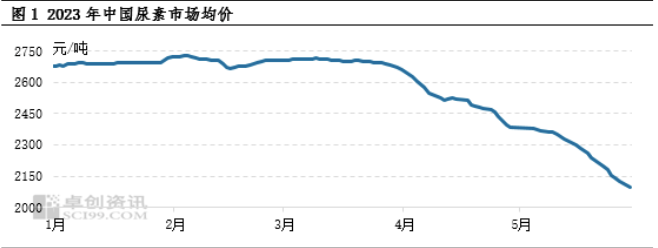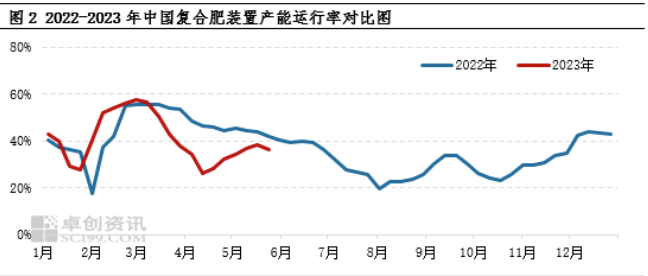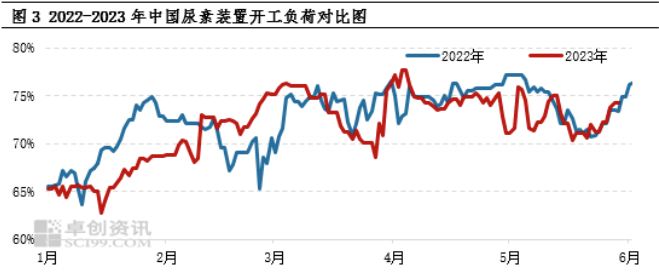Дар бозори мочевина Чин тамоюли коҳиши нарх дар моҳи майи соли 2023 нишон дод. То 30 май, нуқтаи баландтарини нархи мочевина 2378 юан барои як тонна буд, ки 4 май пайдо шуд; Нуқтаи пасттарин 2081 юан барои як тонна буд, ки 30 май пайдо шуд. Дар тӯли моҳи май, бозори дохилии мочевина суст шуданро идома дод ва давраи озодкунии талабот ба таъхир афтод, ки боиси афзоиши фишор ба истеҳсолкунандагон барои интиқол ва афзоиши коҳиши нарх гардид. Фарки байни нарххои баланду паст дар мохи май 297 юан/тоннаро ташкил дод, ки ин назар ба фарки мохи апрель 59 юан/тонна зиёд аст. Сабаби асосии ин пастшавӣ таъхири талаботи қатъӣ ва пас аз он пешниҳоди кофӣ мебошад.
Дар робита ба талабот, захираи захираи поёноб нисбатан эҳтиёткор аст, дар ҳоле ки талаботи кишоварзӣ суст пайгирӣ мешавад. Аз рУи талаботи саноат май ба цикли истехсоли нурихои азотии баланди тобистонй дохил шуд ва иктидори истехсоли нурихои композитй тадричан аз нав cap шуд. Аммо вазъи захираи карбамид дар корхонаҳои нуриҳои композитӣ аз интизориҳои бозор паст буд. Ду сабаби асосй дорад: якум, суръати азхудкунии иктидорхои истехсолии корхонахои нурихои омехта нисбатан кам буда, давра ба таъхир меафтад. Суръати кори иктидорхои истехсоли нурихои омехта дар мохи май 34,97 фоизро ташкил дода, нисбат ба мохи гузашта 4,57 банди фоиз зиёд, вале нисбат ба хамин давраи соли гузашта 8,14 банди фоизй кам шудааст. Дар ибтидои моҳи майи соли гузашта суръати кори иқтидори истеҳсоли нуриҳои омехта ба 45 фоиз расид, вале он танҳо дар нимаи моҳи майи соли равон ба нуқтаи баланд расид; Сониян, кам кардани захираи махсулоти тайёр дар корхонахои нурихои омехта суст аст. То 25 май инвентаризатсияи корхонаҳои нуриҳои омехтаи Чин ба 720000 тонна расид, ки нисбат ба ҳамин давраи соли гузашта 67% зиёд аст. Мӯҳлати равзанаи рафъи талаботи ниҳоӣ ба нуриҳои омехта кӯтоҳ карда шуд ва кӯшишҳои пайгирии харид ва суръати истеҳсолкунандагони ашёи хоми нуриҳои омехта суст шуд, ки дар натиҷа талабот заиф ва захираи истеҳсолкунандагони мочевина афзоиш ёфт. То 25 май захираи ширкат 807000 тоннаро ташкил дод, ки ин нисбат ба охири моҳи апрел тақрибан 42,3% зиёд шуда, ба нархҳо фишор овардааст.
Вобаста ба талаботи кишоварзӣ, дар моҳи май корҳои тайёр кардани нуриҳои кишоварзӣ нисбатан пароканда буданд. Аз як тараф, дар як катор районхои чанубй хушк омадани хаво боиси кашол ёфтани тайёр кардани нурй гардид; Аз сӯйи дигар, пойин рафтани пайвастаи қимати мочевина деҳқононро водор кардааст, ки аз болоравии нарх эҳтиёткор бошанд. Дар муддати кӯтоҳ, аксарияти талабот танҳо сахт аст, ки ташаккули дастгирии устувори талаботро мушкил мекунад. Дар маҷмӯъ, пайгирии талаботи кишоварзӣ аз ҳаҷми ками харид, давраҳои ба таъхир афтодани харид ва дастгирии сусти нархҳо дар моҳи май шаҳодат медиҳад.
Аз чихати таъминот баъзе нарххои ашьёи хом паст шуда, истехсолкунандагон маржаи муайяни фоида ба даст оварданд. Бори кори цехи карбамид хануз ба дарачаи баланд аст. Дар моҳи май сарбории кори корхонаҳои мочевина дар Чин ба таври назаррас тағйир ёфт. То 29 май, сарбории миёнаи кории корхонаҳои мочевина дар моҳи май 70,36% -ро ташкил дод, ки нисбат ба моҳи қаблӣ 4,35 банди фоизӣ коҳиш ёфтааст. Давомнокии истехсолоти корхонахои мочевина хуб буда, ба кам шудани сарбории кор дар нимаи аввали сол асосан аз кор мондани кутохмуддат ва таъмири махаллй таъсир расонд, вале баъд аз он истехсоли махсулот зуд аз нав cap шуд. Илова бар ин, нархи ашёи хом дар бозори аммиаки синтетикӣ поин рафта, истеҳсолкунандагон аз сабаби таъсири захираҳои аммиаки синтетикӣ ва шароити интиқол мочевинаро фаъолона холӣ мекунанд. Сатҳи минбаъдаи харидани нуриҳо дар тобистони июн ба нархи мочевина таъсир мерасонад, ки аввал боло ва баъд коҳиш меёбад.
Дар моҳи июн нархи карбамид дар бозор аввал боло меравад ва баъд поин меравад. Дар аввали моҳи июн, он дар давоми озод аввали талабот ба нуриҳои тобистон буд, дар ҳоле ки нархҳо дар моҳи май идома ёфт. Истеҳсолкунандагон интизориҳои муайян доранд, ки нархҳо поин рафтанро бас мекунанд ва дубора ба боло рафтан мегиранд. Аммо бо ба охир расидани давраи истеҳсолӣ ва афзудани қатъи истеҳсоли корхонаҳои нуриҳои омехта дар марҳилаҳои миёна ва дер айни ҳол хабаре аз нигоҳдории мутамаркази корхонаи карбамид мавҷуд нест, ки аз вазъи барзиёди таъминот шаҳодат медиҳад. Аз ин рӯ, интизор меравад, ки нархи мочевина дар охири моҳи июн ба фишори поинрав дучор шавад.
Вақти фиристодан: июн-02-2023







